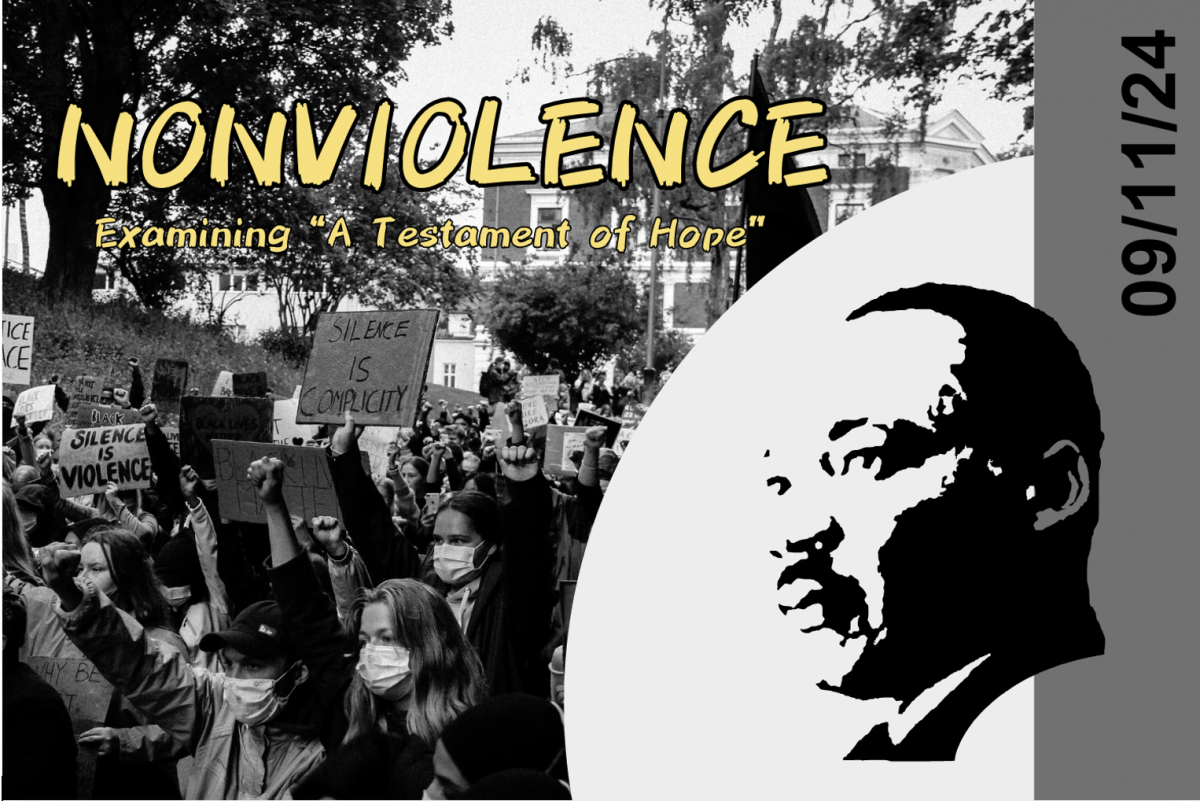英語哲学対話に参加している高校生のRicoが自身の気づきをブログで発信します。

Quick review of ideas from last week:
- Martin Luther King Jr. (MLK) said there are three ways people can respond to oppression
- get used to it (= acquiesce to it)
- rebel or revolt against it
- resist it nonviolently
- MLK wants to promote the third way to respond, and to do that, he argues that he must remain peaceful as “the ends and the means must cohere”.
- In other words, to achieve a nonviolent society, we must take nonviolent actions.
- MLK points out that to be nonviolent, there should not be physical violence (for example, punching or kicking), but also no internal violence (=violence of the spirit).
- Internal violence includes hatred and other negative emotions or feelings that stir up violence.
What we discussed this week:
This week in philosophy we examined the fourth reading from Martin Luther King Jr.’s book, ‘A Testament of Hope’:
There is something else: that one seeks to defeat the unjust system, rather than individuals who are caught in that system. And that one goes on believing that somehow this is the important thing, to get rid of the evil system and not the individual who happens to be misguided, who happened to be misled, who was taught wrong. The thing to do is to get rid of the system and thereby create a moral balance within society.
To begin with, we analyzed the message that the passage intended to convey. MLK claims that we need to change the system of rules that are wrong, rather than the individuals who believe in false or harmful statements. With racism as an example, MLK argues that we should not focus our energies on trying to counter racist people but instead confront the societal systems that promote racism.
Why should that be the case? Part of the reason why I think MLK stresses on the system is because of his earlier argument about nonviolence. To resist nonviolently, a person must avoid both external and internal violence, and this does not come from enduring all the negative emotions and motives, but to let go of them. In this sense, people who resist racism must be accepting and understanding of the racists. As MLK explains, these people are only misguided, and if taught correctly, there would be no reason for them to act racist aside from the hatred, for example. However, since such internal factors of others are uncontrollable, it is important to focus on the system and guiding people appropriately within it.
We decided to talk more about racism in the session, and asked a couple of questions like:
- Is it possible that a person could become racist while living in a social system that isn’t racist?
- Is every instance of slavery an instance of racism as well?
- Is it true that all societies are racist to some extent?
In talking about racism, we felt that slavery was a significant factor since these two concepts have been strongly associated in history. Racism by its nature comes from a set of beliefs that are false and distorted in some way or another. We know that racist beliefs are “false or distorted” because it is illogical to promote that some races are better than others “just because”. Additionally, a lot of assumptions are made about the race based on prejudice rather than empirical evidence. Given this basic definition, people could have been racist without the label to start off with, promoting the incorrect ideas of a specific group of people. This could have happened during the transatlantic slave trade in America as people started to take advantage of the ones living in Africa. However, we cannot be sure of when racism exactly started because it is in the past..
What we know for certainty, however, is that slavery happened in multiple contexts aside from the American context in which we usually learn about racism. For example, groups of people who lost a conflict in history were often enslaved by the ones who won. Therefore, not every instance of slavery was/has been motivated by racism.
Stereotypes were a highlight of the session in discussing racism within society. They can be a useful way to make judgments (especially quick and easy ones), but stereotypes are never the complete picture of who a person is. The stereotypes thus become problematic when people only use stereotypes to assume others without getting to know who they actually are. Because stereotypes exist in humans recognizing patterns, it may be true that all societies are racist to some extent. However, it is still safe to state that not all stereotypes are racist (or discriminatory in some other way).
We finally ended our discussion with a scenario. If you were alone outside at midnight and you turned around and saw a black man walking behind you, would it be racist of you to cross the street?
To be truthful, my response was that I would cross the street—but with a good reason. There are multiple factors that are leading me to think that I should make a quick decision: alone, late at night, and a stranger with potential danger. Given these, I would cross the street because I do not know this person, who may or may not be dangerous. What this means is that it doesn’t have to be a black person for me to cross the street. In fact, I would cross the street if I see a white man or an Asian man behind me. I am prioritizing the sex more than race simply because men have more likelihood and capability of assaulting me than women do. It is common for girls to not be allowed to go outside alone at night for similar reasons. While this does not apply to all men, it does apply to some men, and I do not want to take chances, given that I am alone and it is dark outside. If I see a black woman, I will not cross the street just because; however, if I see any potential in her being dangerous (such as her possessions and her facial expressions), I will cross the street. Again, this applies to a white woman or an Asian woman. If she seems furious about something and she has a knife in her hand, I do not want to take any chances in getting involved in her business.
These examples show that there are many factors to be assessed within the blink of time, and I must quickly make the decision to cross the street. To do so, stereotypes, social trends, and patterns in human behaviors are useful tools to make judgments. Now, I understand that stereotypes are only impartial and do not apply to everyone, but not all stereotypes are made up from nothing. They could come from previous experiences, statistical results, and information from credible media. This said, I would run for my life if I saw a clown walking behind me. This fear originally comes from the horror movie, and it definitely does not apply to all clowns, but some criminals still dress up (ex. wearing Halloween masks) to hide their identities. Keep in mind that I am making quick decisions, and stereotypes can help me protect myself from potential danger. To sum up, I would cross the street if there was a black man behind me, but my decision is not racist.
Today’s session fascinated me because I was able to apply philosophical thinking to historical and social contexts of racism. I used some of the things that I learned at school (slavery, stereotypes, etc) to support my reasoning, and it was also interesting to look back at them from a new philosophical perspective. I feel like we can definitely talk more about this theme because we haven’t even defined what racism is!




